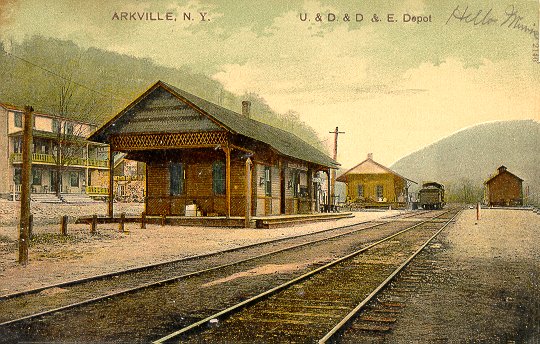| |
ARKVILLE is the next station, four miles further
down the valley and 1,372 feet above tide, the lowest point reached
by the rails in Delaware County. It is an important station because
of the several tributary regions converging here. Margaretville, one
and one-half miles distant on the left is a charming little hamlet at
the base of Mount Pakatakan,  one mile below the
confluence of Dry Brook and the East Branch and partly covering the
ancient site of the Tuscarora Indian headquarters. The rural setting
is marvelously attractive, and many artists of note have built summer
studios here and in the environment of Arkville. There are churches,
stores, water-works, a weekly newspaper, a fair-ground and race-track,
and several hotels. Stages connect with leading trains at Arkville for
Andes, twelve miles, Shavertown fifteen, and Downsville twenty-six miles
away. Furlough Lake, the mountain home one mile below the
confluence of Dry Brook and the East Branch and partly covering the
ancient site of the Tuscarora Indian headquarters. The rural setting
is marvelously attractive, and many artists of note have built summer
studios here and in the environment of Arkville. There are churches,
stores, water-works, a weekly newspaper, a fair-ground and race-track,
and several hotels. Stages connect with leading trains at Arkville for
Andes, twelve miles, Shavertown fifteen, and Downsville twenty-six miles
away. Furlough Lake, the mountain home  of George J. Gould, is only seven
miles distant. This entire region has long been a famous trouting section.
Dry Brook is a favorite stream with fishermen, having ample water to
shield the wary game. Near Arkville is an artificial cave with strange
hieroglyphics rudely carved upon its inner walls, which attracts many
visitors. of George J. Gould, is only seven
miles distant. This entire region has long been a famous trouting section.
Dry Brook is a favorite stream with fishermen, having ample water to
shield the wary game. Near Arkville is an artificial cave with strange
hieroglyphics rudely carved upon its inner walls, which attracts many
visitors.
On leaving this station the train curves sharply toward
the right at an obtuse angle, abandoning its southwesterly course, upon
which it lately entered, and pursuing nearly the opposite direction
for several miles, Arkville being in the vertex of the angle. You are
now entering a charming glade known as the valley of the East Branch;
a fine dairy section, with succulent grasses, milk cows, milk, milk
cans and milk stations in full supply. The little stream loiters lazily
and winds in and out with wondrous beauty through the level vale, evidently
on grace and pleasure bent, for there seems no other reason for avoiding
a straight course, unless it was to increase the charms of the landscape
and annoy the sturdy farmers who till the marginal meadows. To some,
the water may seem to run the wrong way; but it don't.
|

